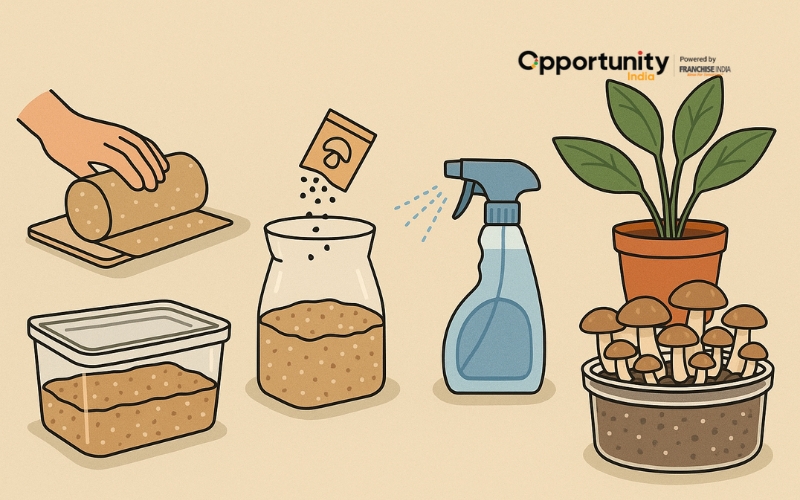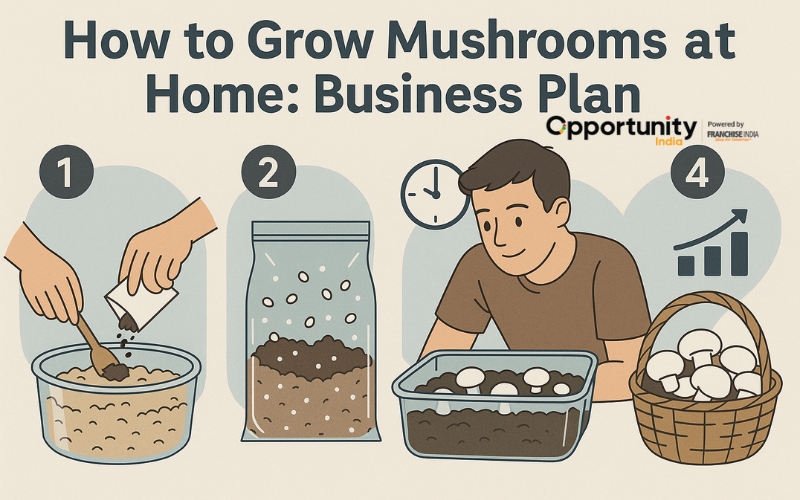
Do you wish to start a mushroom business from the comfort of your home? Growing mushrooms could be your ticket to success in 2025 if you're searching for a low-investment, successful, and sustainable business that you can launch from your home. With the growing popularity of plant-based products, immunity-boosting diets, and organic food, mushroom farming is becoming a popular small-scale business venture. What's the best part? Starting doesn't require a large setup or acres of farmland.
Why Mushrooms Business: The Untapped Potential
Growing mushrooms was traditionally a specialized agricultural endeavor, but it is now quickly becoming a profitable home-based business. Mushrooms have become a popular "superfood" due to growing understanding of their many culinary uses, nutritional advantages, and even therapeutic qualities. India is a major player in the mushroom business, which is expanding significantly worldwide.
Also Read: How to Start a Button Mushroom Farming Business?
India is a major player in the mushroom business, which is expanding significantly globally. The mushroom market in India was valued at USD 1.18 billion in 2023 and is projected to expand at a compound annual growth rate (CAGR) of 12.7% between 2024 and 2030. India's edible mushroom market grew rapidly in 2024 and is expected to reach a value of 347 billion by 2025. Mushroom demand is rising quickly, particularly in India's cities. They are eaten for their health advantages as well as their culinary appeal.

Mushrooms that are high in proteins, vitamins, antioxidants, and therapeutic qualities. This creates opportunities for niche industries like vegan goods, plant-based nutrition, and health. As a result, mushrooms are now utilized in everything from high-end cuisine to medication that increases immunity.
Furthermore, mushroom farming has a minimal negative influence on the environment. Compared to most crops, mushrooms use a lot less water and energy, and they may even be grown on agricultural waste like sawdust, straw, or coffee grounds. This makes it an eco-friendly and climate-friendly business, ideal for business owners who wish to balance profit with purpose. This surge is fueled by several factors:
- Health & Wellness Trend: Packed with protein, vitamins, minerals, and antioxidants, mushrooms are a popular option for people who are concerned about their health.
- Growth of Plant-Based Diets and Veganism: Due to their savory taste and robust texture, mushrooms make a great meat substitute as more individuals choose vegetarian and vegan diets.
- Culinary Versatility: Mushrooms can be used in a vast range of culinary preparations, from ordinary meals to fine dining.
- Medicinal Properties: Some types of mushrooms, such as shiitake and reishi, are becoming more well-known for their therapeutic qualities, which increases their market appeal.
- Government Support and Farmer Awareness: Small and marginal farmers are being empowered by programs that support mushroom growing and training, especially in states that are major producers like Bihar, Odisha, and Haryana.
- Low Initial Investment, High Returns: Mushroom growing offers rapid returns with a relatively low initial investment and less space requirement than traditional agriculture.
Also Read: How to Start a Mushroom Farming Business?
Types of Mushrooms You Can Grow at Home
Start with beginner-friendly varieties before exploring exotic ones. Here are some popular choices:
| Mushroom Type | Difficulty | Time to Harvest | Selling Price (per kg) |
|---|---|---|---|
| Oyster | Easy | 3-4 weeks | ₹150–₹250 |
| Button | Moderate | 5-6 weeks | ₹120–₹200 |
| Shiitake | Moderate | 8-12 weeks | ₹500–₹800 |
| Reishi | Advanced | 3 months | ₹1500–₹3000 (dried) |

Step-by-Step Guide: How to Grow Mushrooms at Home
Although it may seem daunting at first, if you know the fundamentals, starting your own home-based mushroom farm is quite easy. This thorough, easy-to-follow guide will help you start growing mushrooms at home.
Choose the Right Type of Mushroom
Selecting the kind of mushroom to grow is the first and most crucial step. Starting with a variety that is simple to grow and doesn't require complex circumstances is the best option for beginners. Since they grow quickly, produce a lot, and require little care, oyster mushrooms are the most recommended for beginners. For greater earnings and specialized markets, you can try different types of mushrooms, such as button, shiitake, or even reishi, after you have more expertise.
Prepare Your Growing Space
The ideal growing conditions for mushrooms are dim, moist, and well-ventilated areas. You can use a storage space, a spare bathroom, a shady terrace, or even a corner of your kitchen instead of a large room. Make sure the space is pest-free and clean. Additionally, you'll need simple hanging racks or shelving to hold your growth trays or bags. Keep the temperature between 20°C and 30°C and the humidity above 70%. Maintaining the proper moisture levels can be aided by routinely spraying water or using a basic humidifier.
Obtain the Substrate and Spawn
Two essential components are needed to develop mushrooms: substrate and spawn. Similar to a mushroom's seed, spawn is the mycelium that eventually gives rise to mushrooms. You can purchase it from nearby vendors or online. The growing material, or substrate, can be cardboard, sawdust, straw, or coffee grounds. You may either make the substrate yourself or buy ready-to-fruit mushroom grow kits, which come with both spawn and substrate.
Also Read: How to Start a Scrap Business in India 2025?
Sterilize the Substrate
Sterilize your substrate before adding spawn to prevent mold or bacteria that could impede the growth of mushrooms. When utilizing sawdust or straw, this is particularly crucial. Sterilization is as easy as heating the substrate thoroughly or boiling it in water for 30 to 60 minutes. Allow the substrate to cool fully after sterilization before proceeding to the following stage.
Inoculate the Substrate
Mix the substrate with the mushroom spawn in a sterile, clean setting once it has cooled and been cleaned. Depending on your available space, you can put this mixture into bottles, containers, or plastic grow bags. Since mushrooms require airflow to develop, make sure the mixture is packed evenly without being overly tight. Poke tiny holes or openings in the bags or containers after sealing them to let the mushrooms breathe and eventually grow through.
Incubation Period
The mycelium colonizes the substrate during the incubation phase, which follows. For 10 to 14 days, store the bags in a warm, dark place (ideally between 22°C and 28°C). You'll see the white in color, web-like mycelium growing throughout the bag during this stage. This indicates that the mushrooms are growing well. Just make sure the area stays clean and a little damp throughout this time, and don't mess with the arrangement.
Growth and Fruiting
The bags should be moved to a somewhat cooler location with some indirect light once the mycelium has completely colonized them. This will initiate the fruiting stage. Maintain adequate airflow and use a humidifier or water spray to raise the humidity. If you haven't done, make slits in the plastic bags so that mushrooms can grow. Mushroom pins, or little buds, will begin to appear in a few days, and in a week or so, they will be big enough to harvest.
Harvesting the Mushrooms
Twist or cut the mushrooms gently at the base once they are the right size, which is typically 3 to 5 inches for oyster mushrooms. For the finest flavor and texture, it's crucial to harvest them right before they begin to release spores. Depending on the variety and circumstances, a single batch may be harvested several times over several weeks. Following harvesting, the spent substrate can either be thrown away or turned into compost for your garden.
Also Read: Petrol Pump Business Plan in India: The Ultimate Guide
Cleaning and Reusing the Setup
Before beginning a fresh batch, carefully clean your bags, trays, or containers after the fruiting cycle is finished. You can try experimenting with other kinds of mushrooms or keep using the same kind. It's essential to keep your growing area disinfected and clean after each cycle to avoid contamination, mold, or pests in subsequent harvests.
Packaging and Selling
It's time to clean, package, and sell your mushrooms if you're growing them for a living. For fresh mushrooms, use permeable packaging and keep them in a cool location. For a longer shelf life, you can also dry them and sell them online, at restaurants, or in local markets. To increase your consumer base, don't forget to include simple labeling with your brand name, weight, and contact information.
Initial Investment Breakdown: Mushroom Business at Home
| Item | Approx. Cost (INR) |
|---|---|
| Spawn (5 kg) | ₹1,000 |
| Substrate (Straw, Sawdust) | ₹500 |
| Plastic bags/trays | ₹300 |
| Shelves or racks | ₹2,000 |
| Humidifier & thermometer | ₹2,000 |
| Misc. tools & containers | ₹1,000 |
| Total Setup Cost | ₹6,800 |
Growing mushrooms at home is a sustainable and scalable business strategy for the future, not just an enjoyable hobby. This is a lucrative, low-risk business with a lot of possibilities for anyone, whether they are a homemaker, urban farmer, student, or retiree. Gourmet mushrooms can be grown at home and turned into an effective business with a little study, a regulated atmosphere, and regular care.

